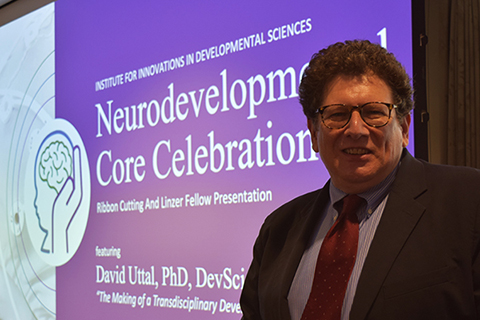Three Secrets For Working Across Disciplines
 A short attention span and the inability to say ‘no’ can be useful traits for atransdisciplinary scientist, Northwestern University’s David Uttal said, only half joking, during an event celebrating a new facility within the Institute for Innovations in Developmental Sciences (DevSci).
A short attention span and the inability to say ‘no’ can be useful traits for atransdisciplinary scientist, Northwestern University’s David Uttal said, only half joking, during an event celebrating a new facility within the Institute for Innovations in Developmental Sciences (DevSci).
Beyond those innate characteristics, which Uttal admits he happens to have, it also helps to work in a supportive environment and be passionate and curious about things outside of your home discipline, he said.
“My interests have always been about maps and other visual representations,” said Uttal, the Dev Sci Linzer Fellow. “Maps open the world, allowing us to think about it in ways that would be impossible based on direct experience alone. Maps create our world - at least the world as we know it.”
Uttal’s presentation “The Making of a Transdisciplinary Scientist” helped mark the official opening of the Evanston location of the DevSci Neurodevelopmental Core at 1801 Maple Ave. This new facility -- another Core space is located on the Chicago campus -- offers researchers in all stages of their careers access to technology, space, support, and expertise in variety of developmentally-sensitive research methods.
A Dev Sci seed fund awardee for his research looking whether iPad apps can help children build spatial skills, Uttal was one of the first researchers to connect the importance of spatial representations and visualizations to Science, Technology, Engineering, and Mathematics (STEM).
Back in 1998, after attending a National Science Foundation conference with organic chemists, he realized that spatial thinking and representations are critical to understanding other STEM fields. A structural geologist, for example, imagines how forces on layers of rocks led to the particular shapes of mountains
Uttal, a developmental and educational psychologist, began studying children’s spatial learning and subsequently partnered with Loyola University professor Catherine Haden. Supported by a $740,000 National Science Foundation Grant, they are researching how children learn and develop an interest in the STEM fields in the Tinkering Lab at the Chicago Children’s Museum.
“Spatial thinking is a very important, but often overlooked, aspect of cognitive development and healthy learning,” said Uttal, a professor of education at the School of Education and Social Policy, and a professor of psychology at the Weinberg College of Arts and Sciences. “There is a great need for better assessments, better diagnostic tools, and better ways of both preventing problems and enhancing positive development.”
On another project, Uttal is designing and evaluating a spatial approach to learning in Career and Technical Education at Chicago Public Schools.
Uttal directs the Spatial Intelligence and Learning Center, which fosters interdisciplinary research and the role of spatial cognition in STEM learning.
He credited Northwestern’s culture of support for interdisciplinary research and lesser-known administrative offices, such as the Office of Residential Academic Initiatives, for setting up informal lunch meetings between faculty and students. “I’ve met several colleagues outside my own discipline at weekly lunches through Shepard and Ayers Residential Colleges,” he said.
His home schools of Weinberg and SESP, meanwhile, are both committed to transdisciplinary research. SESP in particular, is inherently cross-collaborative, with faculty from at least 10 different disciplines. “What brings us together is the interest in, and ability to conduct transdisciplinary research focusing on issues of education and social policy,” he said.
For Uttal, becoming a transdisciplinary scientist is a developmental mission. If you’re interested in collaborating with him, he welcomes the call. “I promise I won’t say ‘no,’” he said.